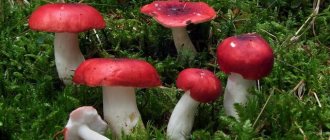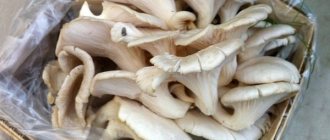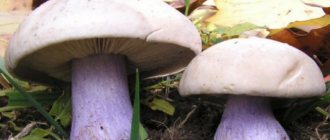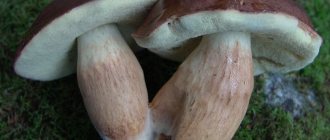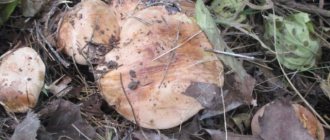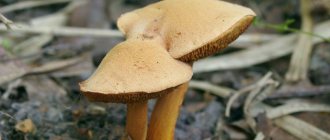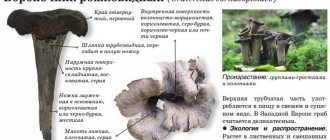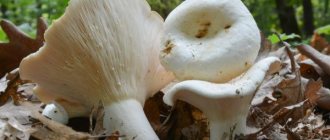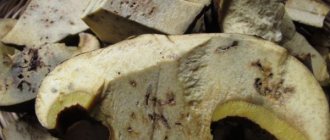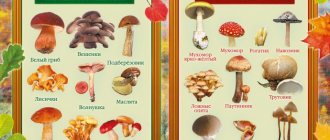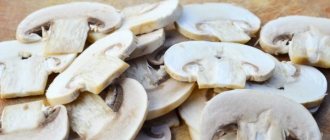Now we will tell you how to check whether mushrooms are poisonous. There are different ways. We'll look at them. They will be useful to housewives and mushroom pickers.
Even on a dreary cloudy day, the forest looks incredibly beautiful. A slow walk along it will help you forget about the daily hustle and bustle for a while and immerse yourself in the magical atmosphere of wild nature. He is generous with his gifts - picking berries and mushrooms brings not only pleasure, but also benefits, because many villagers survive harsh winters thanks to the supplies they make from early spring to late autumn. City dwellers go to the forest more often for recreation, so not everyone knows well how to distinguish a poisonous mushroom from an edible one.
How not to get poisoned?
A variety of dishes with mushrooms are present in almost all cuisines of the world. However, you should not engage in independent collecting if you are not confident in the accuracy of your knowledge and ability to distinguish edible from poisonous. Observing the period (1 day) and storage conditions (in a cool place without direct sunlight). You can safely prepare a delicious product.
Advice: mushrooms are not prepared or stored in aluminum, zinc, or ceramic dishes with glaze to avoid oxidation or reaction of some substances contained in them with the material of the dishes.
A careful attitude towards quiet hunting, as mushroom pickers call collecting the gifts of nature, will help to avoid poisoning. Take only those that you know well. Do not pick mushrooms near a highway, railway track or industrial enterprise.
You have come from the forest, you feel pleasantly tired, and on the table there are only collected mushrooms, alluring with their smell, waiting to be processed. And then you realize that you are not sure that you can eat them. How can you check whether a mushroom is poisonous or not at home? There are many ways to do this. But, unfortunately, it is impossible to reliably determine whether there are poisonous mushrooms among the collected mushrooms.
Here are a few options to help you check. We will also consider myths in parallel.
Edible mushrooms: identification methods (video)
Mushroom pickers should definitely adhere to five basic rules of “quiet” hunting:
- all dangerous, deadly poisonous types of mushrooms must be “known by sight”;
- it is important to carefully examine the mushrooms you collect and be able to distinguish edible species from look-alike mushrooms;
- It is forbidden to collect mushrooms in industrial zones and near highways;
- It is not recommended to pick mushrooms in dry and hot weather;
- You cannot collect overgrown mushrooms, even of edible species.
It is very important to subject the collected mushrooms to thorough heat treatment. The most reliable method is still boiling mushrooms, which allows you to reduce the concentration of toxic substances in the fruiting bodies. A good way is to soak the mushrooms for several hours and change the water multiple times.
Silver and garlic
How to check whether a mushroom is poisonous or not? It is said that a silver object can be dipped into a pan containing this product. And if the silver darkens, it means there is a poisonous mushroom there. But this theory is not 100% correct. Since a reaction may occur with a substance that is released from edible mushrooms.
The changed color of garlic added during cooking also does not one hundred percent confirm the presence of dangerous stalks. After all, a reaction with the enzyme tyrosinase could have occurred, again.
Every good mushroom has its poisonous counterpart!
When picking mushrooms, you need to be very careful. An interesting tip on how to learn to understand mushrooms: after going for mushrooms, you need to sort them by variety: boletus, boletus, chanterelle, etc. If you come across an inedible poisonous double, then in a group of fellow mushrooms it immediately stands out, because in the forest in the heat of the hunt you may not notice it. Even the most noble mushroom - the porcini mushroom - has its own poisonous counterpart - this is the Polish mushroom. When it lies down, its leg begins to turn red; under the cap it has a different color than a porcini mushroom, so it immediately stands out.
The same applies to all other mushrooms; when you sort the mushrooms into piles, you will immediately see which mushroom needs to be thrown away. There is one immutable thing in the rules for collecting mushrooms - if you doubt any mushroom, it must be thrown away immediately.
One more piece of advice regarding lamellar mushrooms: russula, chanterelles, etc. There is a dangerous and poisonous counterpart to these mushrooms - toadstool. Its cap has a grayish-green color, unlike russula, it has a thickening on the lower leg. Therefore, all mushrooms must be collected with stems. If you can't see the stem of the mushroom, you won't be able to tell the difference between the very poisonous toadstool and a good russula. In truth, russulas are classified as conditionally edible mushrooms, and this rule especially applies to lavender and greenish russulas.
It is better to collect pink, orange, and red russulas; you can’t go wrong with them. Pale toadstool is such a poisonous mushroom that if you pick it and see that there is a thickening on the stem, under no circumstances put it in the basket. If you held this mushroom in your hands, and then there is no way to wash your hands, do not touch your mouth, lips, nose, or eyes with them under any circumstances.
The toxins are so strong that through the mucous membranes you can release this poison into the body and become poisoned. If, out of ignorance, one of you picked a toadstool and it ended up in the basket, all the mushrooms should be thrown away. The poison of the pale toadstool is so strong that even its proximity to a good mushroom makes it poisonous. Poisoning with toadstool begins to appear after a day. Sharp abdominal pain, nausea, vomiting appear, and the temperature drops sharply. Nothing can be done at this time.
The poisons of the toadstool kill the liver and kidneys. If possible, such a person needs to undergo a kidney transplant, then there will be a chance of saving him. But if it is not possible to perform an operation, the likelihood of saving a person’s life is very small. So, be extremely careful when picking mushrooms with stems! You can distinguish the pale toadstool from the russula only by the thickening on the lower part of the stem.
How to check if mushrooms are poisonous when cooked?
You can use the following popular method. All you need is an onion. So how to check for poisonous mushrooms? When cooking these products, throw an onion, cut in half, into the pan. If the vegetable turns blue, then the mushrooms should be thrown away, as they are poisonous. These products can cause serious poisoning.
How to check whether a mushroom is poisonous or not? As can be seen from the many verification methods, it is difficult to know for sure. Remember that using such unscientific methods can result in mortal danger!
General description of false mushrooms
The first thing that will help you figure out how to distinguish false mushrooms is a photo and description of their various types.
It is difficult to classify these mushrooms. Their species diversity is widely represented within several families (strophariaceae, dungworts, and, according to another taxonomy, psatirelaceae).
What they have in common with their edible “brothers” is the time of year in which they grow and their habitat – stumps, fallen trees, dead wood, tree roots and trunks.
Due to the similarity of external characteristics - growth in large groups, convex plate-like caps, thin and long legs, hollow inside - at first glance it is difficult for a non-specialist to determine what kind of mushrooms are in front of him. False and “normal” honey mushrooms sometimes even grow next door on the same stump.
Attention! The first rule of experienced mushroom pickers: “If you’re not sure, you can’t take it.”
If there is even the slightest doubt whether it was possible to correctly recognize whether the honey mushrooms are false or not, you should not risk cutting these mushrooms into your basket. You should not take everything in order to figure it out at home or ask specialists. If at least one poisonous mushroom gets into the basket, the rest will have to be thrown in - they can no longer be eaten.
How to properly provide first aid for mushroom poisoning?
If trouble does occur, you should immediately contact a medical facility by calling an ambulance. Before the ambulance arrives, your actions can not only alleviate the suffering of the victim, but also save his life. Act clearly and quickly:
- Don't panic.
- Perform gastric lavage and induce artificial vomiting several times.
- The victim should be placed comfortably in a horizontal position and covered with a blanket.
- Drinking regularly will help prevent dehydration and fight toxins. To do this, you need to drink milk, salted or just clean water.
- Someone should always be near the patient to ensure that the victim is conscious and give ammonia to sniff in case of loss of consciousness, otherwise a coma may occur.
What edible and false honey mushrooms look like (photo)
Edible and false honey mushrooms look almost the same.
However, there are a number of differences that make it possible to separate one from the other. Please pay attention to the following:
- color and shape of the cap;
- the color of the plates on its underside;
- the presence of scales on the surface;
- the presence of a ring growth (“skirt”) around the stem of the mushroom;
- smell.
The photo will help you imagine how to distinguish false and edible honey mushrooms:
Debunking myths
Often, a novice mushroom picker, going into the forest, still has little knowledge of what the main difference is between edible mushrooms and their poisonous counterparts. But most beginners are confident that they will be able to collect only edible prey.
The most important myth, that if you test mushrooms using onions, garlic or some other food components for toxicity, you can avoid food poisoning, has already been debunked earlier. But there are several more equally dangerous misconceptions:
- All young mushrooms are safe to eat. In most cases this is true, but some species are highly poisonous even at a “young age”. For example, accidentally introducing a small toadstool fungus while preparing a dish can be fatal. Experience will come with time, but for beginners it is better to collect only well-known species.
- Everything edible smells delicious. This is a mistake: fly agarics, despite their toxicity, have a pleasant smell.
- Worms don't eat poison. It may seem that slightly nibbled mushroom caps serve as an indicator of non-toxicity and such mushrooms can be collected, but this is not entirely true. Some snails, worm larvae and other insects may simply be immune to fungal poison that is dangerous to humans.
- Prolonged boiling makes the product safe. Indeed, most poisons are eliminated by prolonged boiling with frequent changes of cooking water. But there are also heat-resistant poisons that, if they enter the body even in small quantities, can cause serious digestive disorders.
Many people are familiar with the excitement of a mushroom picker who dreams of collecting a full basket. At the same time, in a hurry, you can put in the box not only the harmless honey mushroom, but also many other representatives of the mushroom kingdom that are dangerous to health. The only thing that can correct the situation is a thorough examination of each of the mushrooms found, which we will talk about below.
False honey mushrooms that look like edible ones
It is necessary to dwell in more detail on the characteristics of the most common types of mushrooms, known as false honey mushrooms, and provide their photos and descriptions.
How to distinguish the bordered galerina from honey mushrooms
One of the most dangerous types of false mushrooms is the fringed galerina.
Warning! The toxins of the toadstool and galerina fringed are identical - eating these mushrooms is dangerous for life!
Characteristic features of galerina fringed:
| Edible or not | Poisonous |
| hat | Small (1–4 cm), bell-shaped, later becoming flat. Color ocher, brown |
| Records | Medium, yellowish (turn brown with age) |
| Pulp | Thin, dirty yellow, with a faint odor and floury taste |
| Leg | 2–5 cm, fibrous, hollow, slightly thickened at the bottom. There is a yellowish ring |
| Season | June – October |
| Habitats | Rotten pine and spruce wood |
| How it grows | In groups of 2–3 pieces. |
The difference between this type of false mushrooms and the real ones will be illustrated by the following photos:
Summer honey fungus:
- larger (hat – up to 6 cm in diameter);
- grows in large “families”;
- the pulp has a pleasant smell and taste;
- the bottom of the leg is covered with scales.
Autumn honey fungus:
- grows in large bunches;
- the flesh is thicker;
- the surface of the stem and cap is covered with scales.
Candoll's honey fungus
The photo below shows what Candolle’s false honey mushrooms look like:
| Edible or not | Conditionally edible |
| hat | Small (3–7 cm), resembles a bell; in a mature one, it is umbrella-shaped with a protrusion in the center. Color varies (from white to yellowish brown). White fringe along the edge |
| Records | Gray, turning brown over time |
| Pulp | Milky brown, with a pleasant mushroom smell |
| Leg | About 10 cm. Hollow, white, slightly pubescent below |
| Season | May – September |
| Habitats | Deciduous tree roots, stumps |
| How it grows | Large groups |
Psatirella moisture-loving
In this photo of false honey mushrooms - psatirella, or watery honey fungus (hydrophilic, spherical), otherwise known as watery honey fungus. This species is very common in Russia.
| Edible or not | Conditionally edible (according to other sources - inedible) |
| hat | Convex, 2–6 cm in diameter. Later it becomes flat. Color – from cream to chocolate |
| Records | Light (darkens with age), frequent |
| Pulp | White-cream color, relatively dense, has no pronounced smell or taste |
| Leg | Hollow, but dense, smooth, 3–8 cm. Light, covered with a powdery coating. There is a false ring |
| Season | June – October |
| Habitats | On wood remains and stumps |
| How it grows | In large groups, uniting in bunches |
Attention! The color of the spore powder of this fungus is purple, which makes it possible to distinguish it from other similar species.
Poppy honey fungus
An idea of what false honey mushrooms look like can be obtained from the example of poppy or gray-plated honey mushrooms.
Important! Although this species is designated as “false,” it is classified as an edible mushroom.
| Edible or not | Edible |
| hat | Medium (3–7 cm), can be either in the form of a hemisphere or spread out, with a convexity. Color – dull yellow to brown |
| Records | Adherent, light yellow, frequently located |
| Pulp | Pale, thin, smells faintly of dampness |
| Leg | 5–10 cm, sometimes curved, yellow above, reddish-brown below |
| Season | Spring – autumn (sometimes even mild winter) |
| Habitats | Coniferous forests, stumps and roots covered with soil |
| How it grows | Bunches |
Sulfur-yellow honey fungus
It is very important for a mushroom picker to keep in mind the description and differences of the false sulfur-yellow honey fungus, since this species is not only inedible, but poisonous.
Attention! Even a single specimen of this mushroom, if placed in a pan with edible varieties, can ruin the dish and cause severe poisoning!
| Edible or not | Poisonous |
| hat | Small (2–7 cm), bell-shaped, then it becomes similar to an umbrella. Color – yellowish with a dirty brown or gray tint, the center is darkened |
| Records | Grown. Young mushrooms are sulfur-yellow, then change color to olive or greenish |
| Pulp | White or yellow-white. Bitter taste, with an unpleasant odor |
| Leg | Approximately 10 cm, light yellow, fibrous, straight |
| Season | June – October |
| Habitats | Rotten branches and trunks, the surface of stumps and the area around them |
| How it grows | Large "families" |
Brick-red honey fungus
The photo below of hemp honey fungus shows a species known as brick red.
In Europe, this mushroom is not considered edible, but dishes made from it are quite popular in Japan and the USA.
Important! The pulp of this mushroom contains strong toxins. Even knowing how to cook it correctly, eating it is risky.
| Edible or not | Conditionally edible (but requires long boiling) |
| hat | Large (from 4 to 12 cm), convex, but becomes flatter with age. Red-brown color (darker in the center) |
| Records | Yellow, over time - brown, attached to the leg |
| Pulp | Pale yellow, bitter taste |
| Leg | Pale yellow above, brown below |
| Season | August – October |
| Habitats | Dead wood |
| How it grows | In groups |
